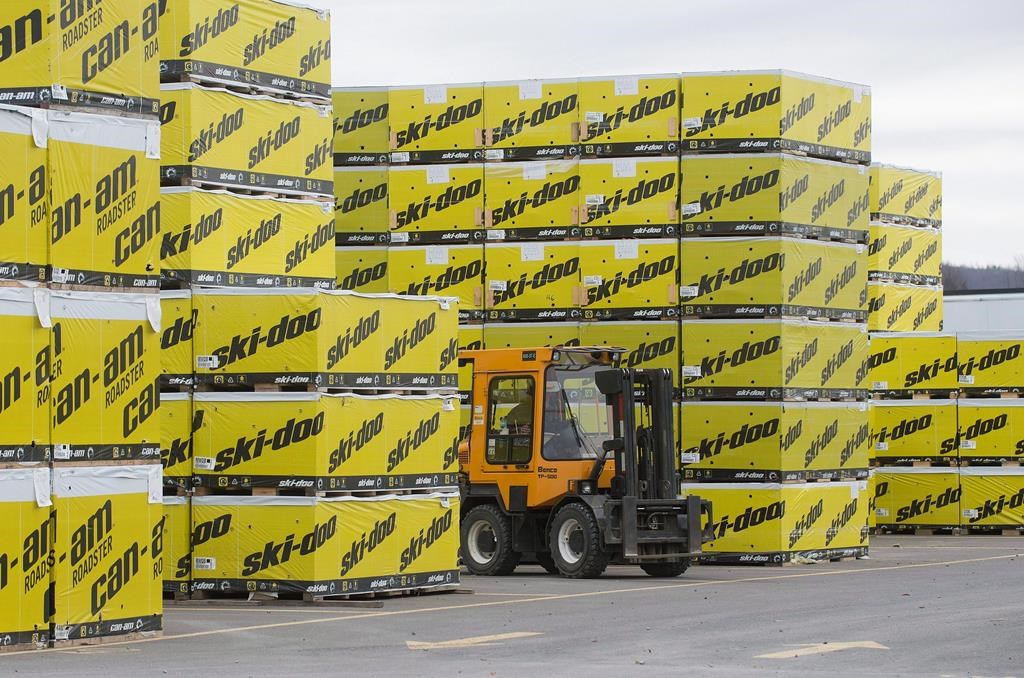The head of BRP Inc. says supply chain woes crimped sales in its latest quarter, with more input obstacles expected on the Ski-Doo maker’s path for the rest of the year.

First-quarter revenues held steady but net income dropped by half from a year earlier due partly to plunging Sea-Doo and off-road vehicle sales prompted by supply disruptions.
“The retail decline does not indicate the lack of consumer demand. Instead it reflects limited product availability,” CEO Jose Boisjoli told analysts on a conference call Friday.
“We expect this trend to continue in the coming quarters as dealer inventory will remain low.”
The earnings results sparked a share price drop of 10.2 per cent or $10.29to $90.29 in afternoon trading Friday on the Toronto Stock Exchange.
The cloudier forecast for the coming months marked a shift from last quarter, when BRP laid out expectations the supply chain would be better lubricated by the second half of the year.
“Now we see that Q2 will be difficult, Q3 will be difficult, maybe some improvement in Q4,” Boisjoli said.
“But we believe also that we have a good way to manage the situation with the modular design of our product line, the product seasonality — then we can favour a product versus the other … And because of our footprint in Mexico, labour availability is good.”
Higher costs and COVID-19 lockdowns in China have pushed BRP to seek alternate supply sources and base production around parts availability. As a result of the bottlenecks, the company plans to manufacture some units “that are missing a few components and retrofit them when we receive the parts,” Boisjoli said.

Get breaking National news
Based in Valcourt, Que., BRP is also among the many vehicle producers feeling the pinch of an ongoing global microchip shortage.
“Sometimes you can find substitutions, but sometimes you cannot,” Boisjoli said, noting that inflationary pressures pile on more concerns.
Despite the snarled supply networks, BRP reaffirmed its guidance, saying it is on track this fiscal year to deliver growth of 11 per cent to 15 per cent for net income, 24 per cent to 29 per cent for revenue and 11 per cent to 14 per cent for normalized earnings per share.
Enjoying a surge in demand since the pandemic as consumers seek new forms of entertainment, the company plans to churn out products at 85 per cent capacity on average across all product lines for the remainder of the year, Boisjoli said.

North American retail sales for powersport — products range from all-terrain vehicles (ATVs) to side-by-sides, three-wheeled roadsters and jet skis — fell nine per cent year over year last quarter, but rose about 30 per cent compared to two years earlier. The performance also outpaced the broader industry, which saw sales tumble by about 20 per cent, according to National Bank analyst Cameron Doerksen.
Customer pre-orders were also up 80 per cent last quarter from the previous year, BRP said, suggesting demand remains strong.
“We acknowledge that retail demand could suffer if the macroeconomic picture deteriorates, but even in that event, restocking demand should support solid wholesale revenue for BRP through 2024,” Doerksen wrote in a note to investors.
BRP reported first-quarter profits of $121 million versus $244.4 million a year earlier, while its year-over-year revenue stayed essentially flat at $1.81 billion.
The maker of snowmobiles and personal watercraft said profits amounted to $1.46 per diluted share for the quarter ending April 30, down from $2.79 per diluted share in the same period a year earlier.
Normalized net income for the quarter amounted to $1.66 per diluted share, down from $2.53 per diluted share a year earlier, BRP reported.
Analysts on average had expected normalized earnings of $1.13 per share and $1.88 billion in revenue, according to market data firm Refinitiv.







Comments